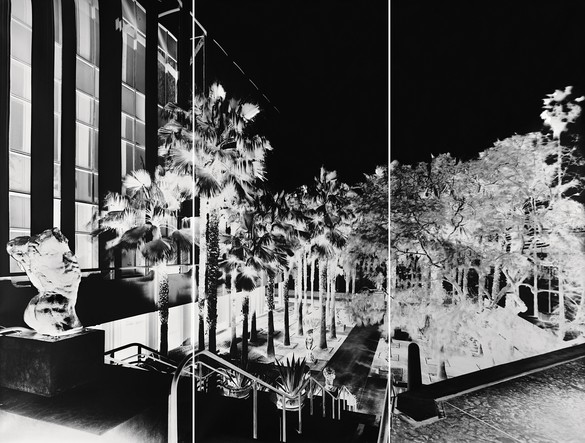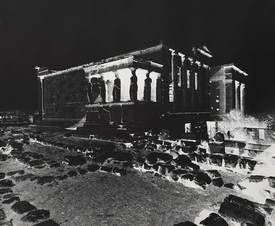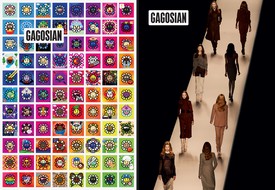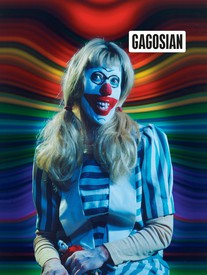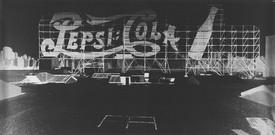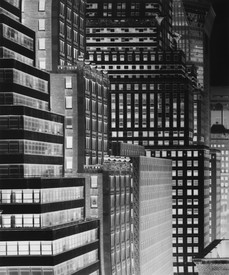Michael Govan I wanted to start with a work of art that you made here at LACMA as part of this residency. It’s an image of the Rodin garden, one of the sites that you selected to look at. Could you talk about this picture and why you made it?
Vera Lutter When you first invited me to come to LACMA and consider the opportunity to portray a museum and its art, I spent a lot of time walking around the museum, thinking about its different aspects. The Rodin garden was of astounding beauty. Standing on the outdoor plaza level, you’re at the palm trees’ midheight, and you feel how the palms move. You’re standing in the wind, in the movement, in the city, and in the museum all at once. That was part of what I tried to capture with this image.
MGThere is this sense of the wind, as there is a blurriness to the foliage in the picture that doesn’t exist in the architecture, which is perfectly sharp. I think that’s one of the most amazing things about this picture, that subtle movement in the foliage. When I first encountered your pictures, I found an aspect of memory or even dream to them. You turn the world into an abstraction of black and white, and then its reversal is a further abstraction. I don’t know if that’s a fair thing to talk about, memory and dream, in relation to this.
VLI’m interested in finding a fairly familiar, often urban place, a place we all know well, and in turning this image into my work. I want to keep it recognizable but place it at the edge of something new that makes us interested in exploring what it really is that we’re looking at.
MGWhen I originally asked if you would be interested in doing this, I had this idea that we often remember our past through snapshots, that it becomes harder to conjure actual memories without a picture. People will remember some of the buildings at LACMA, Robert Irwin’s Primal Palm Garden, this particular arrangement of Rodin . . . Somehow the picture is a kind of ever present memory. I don’t know if you ever think about that in terms of how these images function.
VLAbsolutely, but there are so many different forms of memory, and different layers of those forms as well. Some images I found in dreams, others just come up or become clear as I see something in the world. What I make of them is very different. Some of the images I have yet to realize because I haven’t yet found an opportunity in reality to bring them about. I’ve always thought that I’m in a way mapping the world for myself; this map is of course also a memory. After I moved to New York, especially in the beginning, I was excited about the city and I wanted to make it my own, adopt it. Making images of it was an attempt to do so.
Mazzanti painted martyrdom, but in my image we look at its reversal and realize it is an ascension.
Vera Lutter
MGYou’re not a photographer in a traditional sense, because most photographers see something and then make a picture of it. I remember our first conversations, about helping you get into airports—you had a dreamlike image and you were looking for the place that met the dream. But it seems like you have an image in your mind and then you have to find the thing that fits it.
VLThat’s right. I know the image I want to make, but then I have to find a place in the world that offers me that opportunity and work on it until it matches my mind’s eye.
MGHow this project came about in part was that you had in your mind’s eye an image of museums, right? You had done a few experiments where you had taken your smaller camera into museums and made images of works of art. I feel like you conjured us as a site as well, maybe.
VLThat sounds right, I had an idea and I called you. It’s charming to think I conjured you as a site, but I also knew that you were the only person I could do this with.
MGThe project really had three parts as we resolved it, which were, one, to look at the exterior of the museum; two, to create what we joked about as “copy stand” images, since your interest was also in making images of other art; and three, the notion of the museum interior. On the second of these principles, you said you’d been interested in photographing collections but people were a little unsure about letting you take an expensive painting to your studio to make an image. In our case we brought you to the museum and you lived in the museum for a while. But working inside a museum, and working with masterpieces of art, is complicated. We had to figure it out through months of discussion. For one of your first very large images of pictures in the collection, for example, you took a big European painting, Ludovico Mazzanti’s Death of Lucretia [c. 1735–37], and made an image that had an exposure time of around thirty-five days, plus or minus. Patrice Marandel was chief curator of European art at the time, and one of the things he said about your picture is that the subject of the painting is martyrdom, and somehow you turned martyrdom into ascension. That was a complete transformation of one subject into another. Your photograph is and is not a document of the original painting.
I know you’d never made a picture like this before. Did you have an idea of what you would get through this process?
VLI seem to always know, but then my work continues to surprise me. I believe I succeeded in extracting an essence from the artworks I photographed. Transferring them into a black-and-white negative form lets us see their skeleton and structure. It’s a reductive process, in a way a simplification that eliminates distractions. In our case Mazzanti painted martyrdom, but in my image we look at its reversal and realize it is an ascension. Obviously I am happy to have succeeded in demonstrating this on my first attempt.
MGBut this wasn’t in your mind’s eye for a while. You had done other, smaller experiments, but you’d never actually had a chance to make a big picture of another picture.
VLNo, it started with my desire to photograph sculpture. A friend who is a curator at the Metropolitan Museum of Art in New York made it possible for me to photograph in the Greek and Roman collection. I was interested in the fragmented body, the rupture between the once perfect antiquity and what we see today. I photographed works with a smaller, portable version of my camera obscura. After that first step, the National Gallery of Art in Washington invited me to work with them, and back in New York, the Museum of Modern Art asked me to participate in a project about its sculpture garden. All of those projects were about sculpture; before working with LACMA, I’d never photographed painting.
MGFor me, though, paintings become more sculptural in your work. Somehow the black-and-white abstraction, the dark chiaroscuro, the light and shade, bring out figures that have a strange kinship to some of your other images of objects and things. They lose some of their flatness. Without the frame, I’m not sure they would read as paintings.
VLYes, that would be another success of this transformation through my work, but I can only show it because it’s already in the painting.
MGOne picture that surprised me definitely has a sculptural quality, the image of objects in our Oceanic tribal-arts collection. How did this picture come to be in your mind?
VLWhen we structured our project in three parts, as the “trilogy” it became, we started with the anchor of the gallery interior, the European old master painting gallery. You pretty quickly followed up with the wish to create a record of the exterior architecture—back to the idea of memory, you wanted an artistic memory of what was there before it was to change. Then there was also the “copy stand” idea of photographing works from the collection directly and individually. To help me do that the museum created secured spaces in the galleries where I was able to install and photograph pieces of my choice for periods of up to two or three months.
I was excited to find the amazing installation of Oceanic art at LACMA when I first visited you. Curator Nancy Thomas generously allowed me to work with the collection, which was really a dream come true, something incredibly great and fulfilling for me. With the help of LACMA’s team and my assistants, we spent days and days arranging these works in front of my camera. I sat inside the camera, looking at the reversed and upside-down projected image with a wide-open lens, and instructed the team.
MGWe should talk about the scale of the camera you’ve been using here at the museum. As you say, it’s a camera you can sit in.
VLYes, it’s a pinhole camera and the scale is architectural, like a small cabin, about nine feet tall with a ten-by-six-foot footprint. Of course it’s completely light tight and therefore dark inside. I usually sit with my back to the lens and look at the image projected on the screen. It takes about a half hour for the eye to adjust to the very little light that comes though the pinhole. At that point one can see the projected image clearly.
MGAnd you’re using a larger hole here too, not just pinhole size, so that you can get a test image. With the bigger hole you get something that in pinhole-camera terms is like an instant image—what might take months with the pinhole takes a few days?
VLThat’s right. This is new for me and became a necessity when making images in galleries with very low light levels. The larger opening projects a brighter image, which is of course much less focused, but it lets me determine what I’m seeing and what I’m doing.
In any case, after this extensive installation of the Oceanic works, we came up with the arrangement in the photograph. It is intentionally ahistorical and intuitive, bringing creatures together that aren’t from the same tribe or island and might not really speak the same language, but I wanted them to interact with one another and I believe I succeeded in doing that. This was a three-month exposure and for all that time I kept that part of the collection in my secured space. The museum maintained it meticulously every day during this period.
MGOn one level it might not make art-historical or geographic sense, but it is also true that these objects weren’t meant for museums; they were meant to be animated, to be part of performances, to be living things. I think that in this picture is a kind of living abstracted energy.
VLMy technique lets me change the scale of objects. Some appear to be much bigger in the image than they really are, and they gain greater prominence, displaying their full spirit and power.
the most wonderful experience was the intimate and almost unlimited exposure to art. The museum gave me such deep and personal time with art, the kind of time that is necessarily revealing on many levels.
Vera Lutter
MG I want to go back now to your discovery of this approach: it uses photographic techniques but it’s a lot like painting, and we’ve talked about your involvement in sculpture. I know architecture, too, is very much part of it because you literally build spaces to make pictures. Your first camera was—
VLMy bedroom.
MGYour bedroom. Can you talk a little about this? It’s a bit of an epiphany. You’d never even picked up a camera to make art, right?
VLJust before I left Munich for New York, in 1993, I experimented a little with photographic collage work, but before that I made ceramics and then objects. I knew change was in the air so it was great to come to New York. I lived in a terrific space on the twenty-seventh floor of a high-rise in the Garment District with fabulous views to the east over the entire neighborhood and the Empire State Building. The view south was the World Trade Center and Ellis Island. This was so new and impressive that in my first piece I wanted to bring all these impressions of my new life into one image. That’s when the idea came up to turn the space into a camera obscura, to capture these many impressions and sensations.
MGIn addition, you’re using your portable camera on Wednesdays, when we’re closed to the public. Between 5 p.m. on Tuesday and 11 a.m. on Thursday is just enough time to be able to make what we’ve been calling the “point and shoot” pictures, where you use a smaller box.
VLYes, these smaller box cameras of mine are roughly thirty by twenty by fifteen inches. I came up with that early on, when I started doing this work. It was hard for me to find locations that would accommodate my request to photograph using a room-size camera. In the museum it gave me the flexibility to move through the galleries and experiment with time and light and the great variety of art displayed. These small images are surprisingly hard to make—time and again I’m surprised how hard they are.
MGAre there things you’ve learned from being in the museum, things you’re going to do in the future because of this?
VLI learn every day, every hour I make work, but this has been an extraordinary opportunity to work in a way that I probably never will again. At LACMA I had four room-sized cameras installed, all of them recording at the same time but essentially different installations or aspects of the museum. One of them had two seven-month runs, another began on an exterior site and then was brought into the museum and used there for a three-month exposure. Given the complexity of the installations, the enormous timeline, the expertise in lighting, and much more, the opportunities the museum afforded me were entirely unique. But the most wonderful experience was the intimate and almost unlimited exposure to art. The museum gave me such deep and personal time with art, the kind of time that is necessarily revealing on many levels. It was a unique experience, and the outcome, however carefully I planned and thought it through, was always a surprise to some degree. Every moment was learning.
Vera Lutter: Museum in the Camera, Los Angeles County Museum of Art, dates to be announced; text: © 2020 Museum Associates/LACMA; artwork © Vera Lutter
